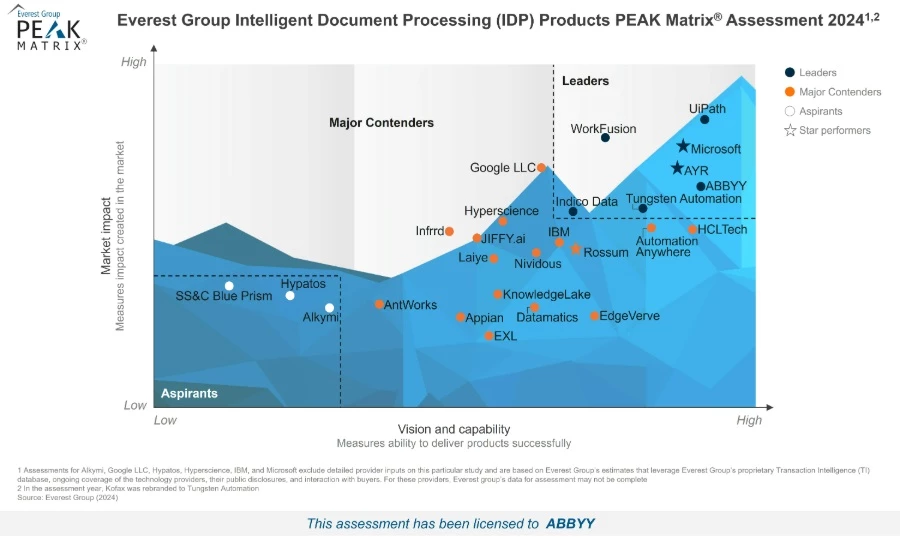HeroSecondaryQuote
JSS component is missing React implementation. See the developer console for more information.
BlockQuote
JSS component is missing React implementation. See the developer console for more information.
According to Forrester’s Business and Technology Services Survey, change resistance is among the five most frequently selected challenges in executing digital transformation: 21% of global services decision-makers supporting their organization’s digital transformation cited implementation of new processes and capabilities as one of their greatest challenges.
We know that managing change is hard; we see it all the time while working closely with our customers to help them achieve their business goals through automation and purpose-built AI. But we also see them succeed when they when focus on creative and realistic approaches to change management that emphasize the success of all stakeholders in a process.
Here are some things that our customers have identified as important in successfully managing change in their organizations—real-world experience that can help your own transition to run smoothly.
Look for flexibility and responsiveness
Reinforce what works well.
For one transportation and logistics company, it was important that the solution they chose was sufficiently flexible to strengthen the processes that were already working well. Retention of established processes, including existing automation, in their entirety, was essential for this organization. The solution they chose offered easy-to-use, flexible business rules to reflect current best practices already in place. It also integrated easily, out of the box, with a wide variety of systems working in conjunction with document processing: ERP, ECM, CRM, BPM, LOB, and RPA systems.
Tailor operations to make their jobs easier.
For many organizations, the corporate benefit behind adopting intelligent document processing (IDP) is to reduce cost, increase efficiency, and better realize business goals. But workers are much more motivated by change that makes their jobs easier, like relief from tedious manual work that often needs to be redone. A high degree of straight-through or touchless processing based on business rules and integrations is not only good for the business but increases accuracy and job satisfaction (which also helps retain talent). One technology company we worked with was looking for a better user experience, especially when manual correction is necessary. Right out of the box, IDP delivered upwards of 90% accuracy. And the solution continues to get smarter and more accurate over time, learning as new document variations and statistical data is collected during human-in-the-loop review.
Identify and relieve points of friction that frustrate users.
One business process outsourcing (BPO) company wanted to improve their customer journey based on what the actual data from the process indicated. Process mining data shows them the most efficient and cost-effective path, and highlights existing deviations. This allows them to assess proposed improvements before spending time, effort, and cash to put them in place.
Similarly, a large healthcare provider used process intelligence to gather accurate and detailed information on what’s working in their document processing, what’s not, and why, catching and resolving deviations from best practices in real time.
Don’t leave staff hanging: Implement quickly.
The implementation of AI-driven automation is a critical time for change management. It needs to be as smooth and as fast as possible, in every industry and use case. What should you expect? A BPO customer of ours saw improvements in only 2 weeks. For a transportation and logistics company, software was test-ready just four days after being installed. A financial services firm was able to develop and deploy their project in record speed, under 6 weeks.
How you implement is also a factor. A large healthcare provider was successful in choosing to make process improvements one-by-one, so that as staff became familiar and comfortable with the first change, layers could be added, evolving more impactful solutions.

How solution providers enable and enrich users
Relieving the pain of a user’s tedious work is one thing. Improving their existing skill sets and adding new ones adds value that advances careers (as well as ensuring a good, rapid return on your business investment).
Partner tightly with a seasoned solution provider.
A large construction firm ascribed smooth change management to the direct access they enjoyed to the provider’s experts who would respond on the spot. Look for support from a solution provider with resources available on-site and remotely to assist with all aspects of the implementation of an intelligent document processing solution: consulting, requirements gathering, business analytics, integration design, solution architecture, individualized training, and more.
Ensure strong support for the newest technology.
One business process outsourcing firm, adopting process intelligence for the first time, credited the vendor’s aftercare and support with building out staff expertise in process and task mining. They didn’t want to hire a whole new army of data scientists and analysts to work on a new solution. They wanted something that was out of the box, user friendly, and intuitive so their existing team could pick it up relatively quickly and start using it.
Shorten the learning curve.
Of course, the starting point for any intelligent document processing solution should be that it requires minimal, if any, special skills to operate or manage. While document processing tasks are familiar to many businesses, the way an intelligent solution solves familiar tasks typically requires knowledge transfer that maps how the new solution handles them.
Knowledge transfer can be “old school” if the quality is there. An order-to-cash business pointed to the highly professional, thorough documentation that accompanied a facilitated implementation. Most solution vendors offer some form of training. Look for varied, flexible offerings that give users choice in how to build their skills, maximizing their success and reducing change resistance.
Enable and reward advanced skills.
A product engineering and technology consulting business can now apply artificial intelligence technology to extract data from documents, using pre-trained models, or skills, that provide a no-code approach to using AI and machine learning technology. The ease of the web browser-based UI in training the system to manage new types of invoices was cited as a key factor. Role-based certification (product-specific specialist, developer, business analyst, solution architect) is a formal recognition of increasing command of the solution—personally rewarding for the individual as well as for the business in the success of its digital transformation initiatives.
Managing change moving forward
Managing change during the implementation phase of digital transformation is crucial. But what about managing the change that occurs over time, without adding great costs?
Manage change in-house.
An agriculture business noted the flexibility and ease of reconfiguring the solution they chose. For a railway company, choosing an intelligent solution that is easily adaptable gives them the flexibility to make changes in-house. For a firm specializing in product engineering and technology consulting, it was the no-code approach to making development changes that held value for them.
Make sure it’s easy to scale.
Nothing kills enthusiasm for digital transformation when a solution falls behind in supporting high-volume and fast document processing scenarios. Centralized configuration and management make it easier to control multi-server installations, distributed infrastructure, and operators. Intelligent document processing should also remove limits on the amount and type of information that can be extracted and made actionable. For one transportation business, a key result of their transformation is the ability to continually increase the type of invoice data upon which they can operate (which adds value to their role as consultants in the industry).
Change management checklist
If your company is looking to optimize user adoption and better manage change resistance in your digital transformation, here’s a checklist of the factors mentioned in this article; factors encountered by businesses who have already successfully implemented intelligent document processing and process intelligence.
Look for evidence of flexibility and responsiveness:
- Easy-to-use, flexible business rules and out-of-the box integrations
- The highest degree of straight-through or touchless processing
- Automatically gets smarter and more accurate over time
- Flexible workflow customization through scripts and webservice APIs
- Enables discovery of sources of user frustration
- Fast implementation measured in days or weeks
- Smooth implementation through ability to make process improvements one-by-one
Look at solution providers for the ways they enable and enrich users:
- Direct, on-the-spot access to a seasoned provider’s experts
- Resources to help with all aspects of solution implementation
- Strong aftercare and support, especially for new technologies like process mining and artificial intelligence and low-code development
- High-quality documentation and training modes that fit individual learning needs
- Application of advanced technology (AI/ML) through user-friendly, web browser-based UI
- Role-based certification that document a user’s advanced skills
Choose solutions engineered for managing change moving forward:
- Supports that enable you to manage change in-house (easy reconfiguration, no-code development)
- Scalable in terms of performance, centralized configuration, and management
- No limits on the amount and type of information that can be made actionable
Subscribe for updates
Get updated on the latest insights and perspectives for business & technology leaders
ConnectWithUs
JSS component is missing React implementation. See the developer console for more information.
